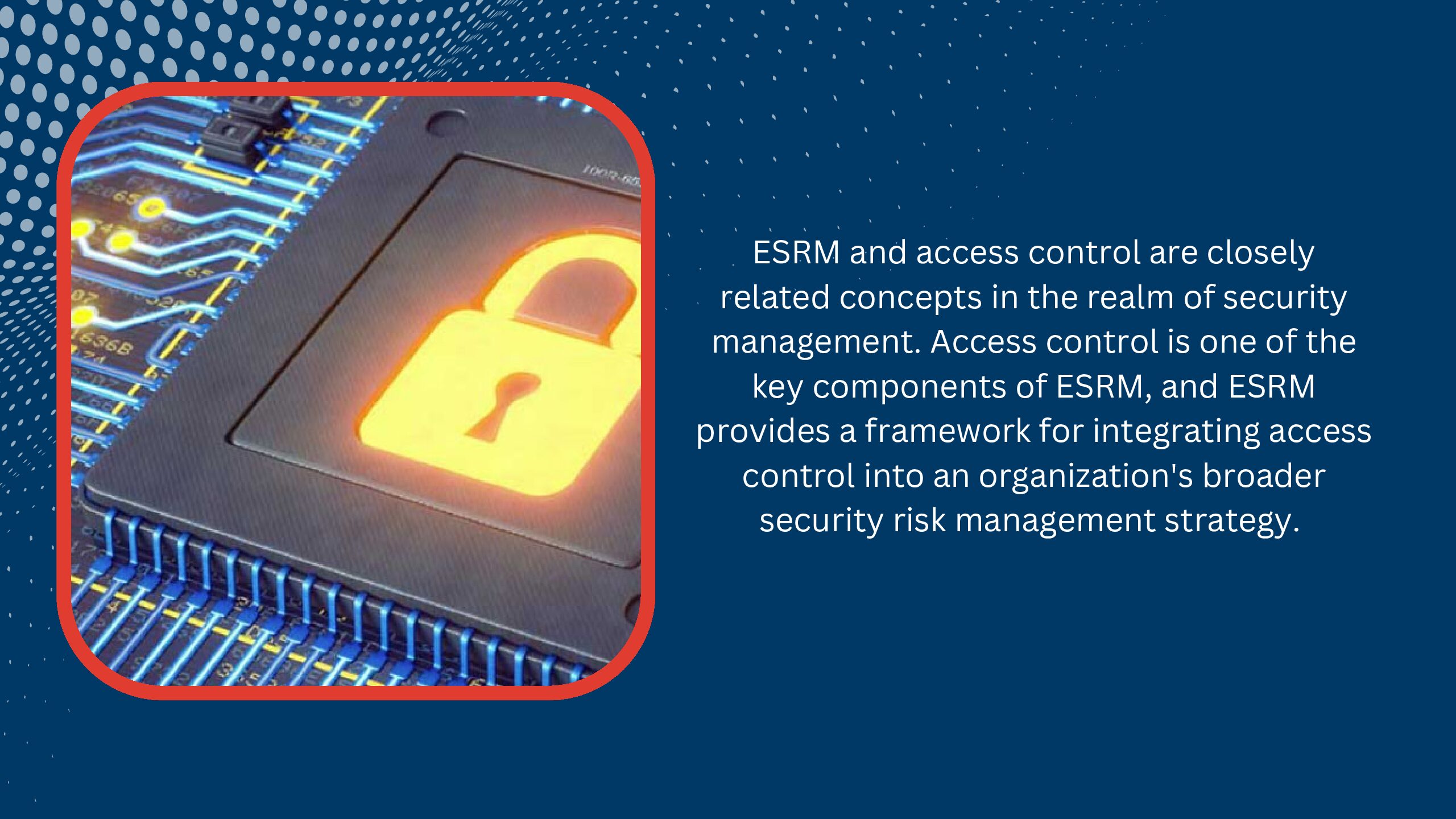ESRM, or Electronic Security Risk Management, is an approach to managing security risks in an organization that integrates electronic security systems and technology with broader risk management principles. It focuses on identifying, assessing, and mitigating security risks through the use of electronic security measures and technology, such as surveillance cameras, access control systems, and intrusion detection systems tools.
Key components of ESRM include:
- Risk Assessment: ESRM starts with a comprehensive assessment of security risks that an organization faces. This involves identifying potential threats, vulnerabilities, and the potential impact of security incidents.
- Integration: ESRM emphasizes the integration of electronic security systems and technology into the organization’s overall risk management strategy. This integration ensures that security measures align with the organization’s objectives and risk tolerance.
- Collaboration: ESRM promotes collaboration among different departments within an organization, such as security, IT, facilities management, and legal. Effective communication and cooperation are essential for addressing security risks effectively.
- Continuous Monitoring: ESRM involves continuous monitoring of security systems and the threat landscape to identify emerging risks and vulnerabilities. This allows for proactive risk mitigation.
- Risk Mitigation: Once risks are identified and assessed, ESRM seeks to mitigate these risks through a combination of electronic security measures, policies, procedures, and training. This may include implementing advanced access control systems, surveillance technology, firewalls, and encryption protocols.
- Metrics and Reporting: ESRM emphasizes the use of metrics and reporting to measure the effectiveness of security measures and to demonstrate the return on investment in security technology and processes.
The relationship between ESRM and Access Control
Electronic Security Risk Management (ESRM) and access control are closely related concepts in the realm of security management. Access control is one of the key components of ESRM, and ESRM provides a framework for integrating access control into an organization’s broader security risk management strategy. Here’s how they are connected:
- Risk Assessment: ESRM begins with a risk assessment, which involves identifying security risks, threats, vulnerabilities, and potential impacts. Access control is a critical element in this process as it helps assess and mitigate risk related to unauthorized access to physical and digital assets.
- Integration: ESRM emphasizes the integration of access control systems into the overall security strategy. Access control systems, which include technologies like card readers, biometric scanners, and electronic locks, are used to manage and restrict entry to physical spaces or digital resources. Integrating these systems with the broader risk management strategy ensures that access control measures align with the organization’s risk tolerance and objectives.
- Continuous Monitoring: Access control systems play a role in continuous monitoring by logging access events and generating alerts for suspicious or unauthorized activities. These logs can be used as part of the broader monitoring efforts within ESRM to detect security incidents and assess their impact.
- Risk Mitigation: Access control is a primary means of mitigating risks associated with unauthorized access. ESRM helps organizations determine the appropriate level of access control measures based on the identified risks. For example, sensitive areas may require stricter access controls than less critical areas.
- Adaptation: Both ESRM and access control recognize that security risks are dynamic and evolving. As threats change, access control measures may need to be adjusted or enhanced to address new challenges. ESRM provides a framework for organizations to adapt their access control strategies in response to changing threat landscapes.
- Collaboration: ESRM promotes collaboration among different departments within an organization, including security, IT, and facilities management. Access control often involves coordination between these departments to ensure that physical and digital access controls are aligned and effectively managed.
Before you do anything…
Before implementing Electronic Security Risk Management (ESRM) within an organization, several important steps and considerations should take place to ensure its effectiveness. Here are key preparatory steps:
- Executive Leadership Buy-In: Obtain support and commitment from senior executives and leadership within the organization. ESRM requires top-down support to allocate resources, define priorities, and promote a security culture.
- Risk Assessment: Conduct a comprehensive risk assessment to identify security risks and vulnerabilities across physical and digital domains. This assessment serves as the foundation for ESRM planning.
- Establish Objectives: Clearly define the organization’s security objectives, goals, and desired outcomes. These should align with the organization’s overall mission and values.
- Allocate Resources: Determine the budget, personnel, and technology resources required to implement ESRM effectively. Adequate resources are critical for risk mitigation and system integration.
- Security Policies and Procedures: Review and, if necessary, update existing security policies, procedures, and guidelines to align with the ESRM approach. Ensure that these documents reflect the organization’s risk tolerance and objectives.
- Collaborative Framework: Establish a framework for collaboration among different departments and stakeholders within the organization. ESRM encourages cooperation among security, IT, facilities management, legal, and other relevant departments.
- Training and Education: Provide training and education for employees at all levels of the organization. This includes raising awareness about security risks, best practices, and the role each employee plays in security.
- Technology Assessment: Evaluate existing security technologies, systems, and infrastructure to identify gaps or areas for improvement. Determine if upgrades or replacements are necessary to support ESRM goals.
- Compliance and Legal Considerations: Ensure that the ESRM strategy complies with relevant legal and regulatory requirements. This may involve consulting legal experts and understanding data protection laws, industry regulations, and privacy requirements.
- Incident Response Plan: Develop or revise an incident response plan that outlines how security incidents will be handled within the ESRM framework. Ensure that all relevant stakeholders are aware of their roles and responsibilities in the event of an incident.
- Testing and Simulation: Conduct security testing and simulation exercises to assess the organization’s readiness to respond to security incidents and to identify weaknesses in the ESRM implementation.
- Metrics and Reporting: Define key performance indicators (KPIs) and reporting mechanisms to measure the effectiveness of the ESRM program. Regularly review and adjust these metrics as needed.
- Documentation: Maintain thorough documentation of the ESRM strategy, risk assessments, policies, procedures, and incident response plans. Documentation is essential for accountability and transparency.
- Communication Plan: Develop a communication plan to keep all stakeholders informed about the ESRM program’s progress, changes, and successes.
- Monitoring and Adaptation: Implement monitoring mechanisms to continuously assess the effectiveness of ESRM. Be prepared to adapt and adjust the strategy as security risks evolve.
By addressing these 15 steps before implementing ESRM, an organization can build a solid foundation for a comprehensive security risk management approach that integrates electronic security measures effectively with broader risk management principles. Wittenbach is there for you every step of the way with a fifty-year track record of reliable solutions and excellent customer service.
In summary
ESRM is a holistic approach to security management that recognizes the importance of electronic security systems in modern organizations but places them within the context of broader risk management practices. It helps organizations identify and address security risks more effectively and efficiently while aligning security efforts with the overall goals of the organization.
Access control is a fundamental component of ESRM, and ESRM provides the strategic framework for organizations to manage access control systems in a way that aligns with their overall security risk management goals. This integration ensures that access control measures are not implemented in isolation but as part of a comprehensive approach to security management.
Your partner for ESRM execution is critical to the success of your program. Our project managers, engineering staff, electronic monitoring services and customer service all work together to align with your goals for your organization. Please visit www.wittenbachsecurity.com for more details.


